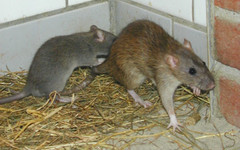Social behaviour
Social interaction with conspecifics (own kind) is very important. Rats display a wide range of social behaviours in which pheromones play an important role (see movie 1). Social ranking among rats is indicated by the degree of submissiveness an animal displays towards a cage mate during a conflict (i.e. lying flat on its back, see movie 2).
Preserved wild rat behaviour
Shortly after having been placed in a semi-natural environment, laboratory bred rats will start to show much of the behaviour of their wild counterparts, indicating that wild rat behaviour is preserved in laboratory rats. An interesting documentary on the subject can be found on the website Ratlife. The documentary's central question was: "We may have taken the rat out of the wild, but have we taken the wild out of the rat?".
Natural rat behaviour
Rat cages need to be adapted to essential aspects of rat behaviour such as rearing (standing on hind legs) to survey the environment and the availability of materials to gnaw on, provided this does not interfere with the experiment.
Young rats are more active than older animals and females are generally more active than males.
Rats groups are hierarchical and this characteristic must be kept in mind during restrictive feeding, because dominant animals will take more food than submissive ones.



